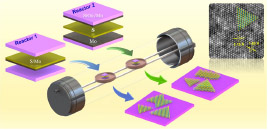Department of Physics and Astronomy: Publications and Other Research
Date of this Version
2012
Document Type
Article
Citation
PHYSICAL REVIEW B 85, 214115
Abstract
Using piezoresponse force microscopy on epitaxial ferroelectric thin films, we have measured the evolution of domain wall roughening as a result of heat-quench cycles up to 735 ◦C, with the effective roughness exponent ζ changing from 0.25 to 0.5. We discuss two possible mechanisms for the observed ζ increase: a quench from a thermal one-dimensional configuration and from a locally equilibrated pinned configuration with a crossover from a two- to one-dimensional regime. We find that the postquench spatial structure of the metastable states, qualitatively consistent with the existence of a growing dynamical length scale whose ultraslow evolution is primarily controlled by the defect configuration and heating process parameters, makes the second scenario more plausible. This interpretation suggests that pinning is relevant in a wide range of temperatures and, in particular, that purely thermal domain wall configurations might not be observable in this glassy system.We also demonstrate the crucial effects of oxygen vacancies in stabilizing domain structures.


Comments
Used by permission.